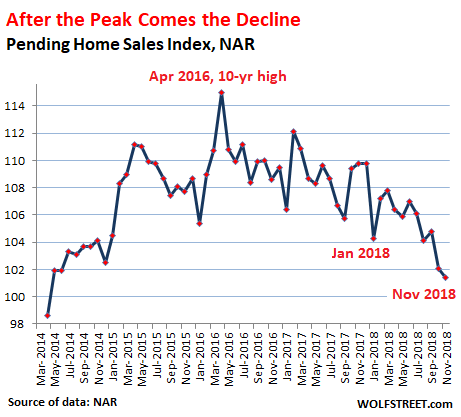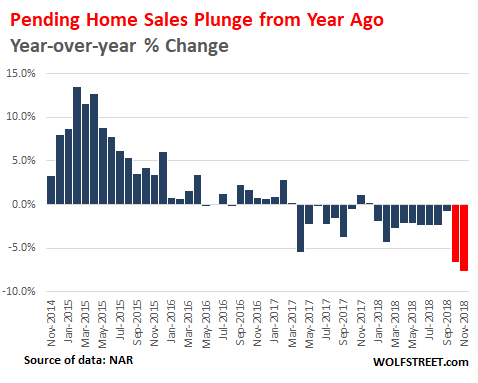Wolf Richter wolfstreet.com, http://www.amazon.com/author/wolfrichter
Sales decline to steepen, no respite in sight.
The reasons for the housing-market downturn are in the eye of the beholder, as we will see in a moment. But whatever the reasons for it may be, the data on the housing market is getting uglier by the month.
Pending home sales is a forward-looking measure. It counts how many contracts were signed, rather than how many sales actually closed that month. There can be a lag of about a month or two between signing the contract and closing the sale. This morning, the National Association of Realtors (NAR) released its Pending Home Sales Index for November, an indication of the direction of actual sales to be reported for December and January. This index for November fell to the lowest level since May 2014:

“There is no reason to be concerned,” the report said, reassuringly. And it predicted “solid growth potential for the long-term.”
And the index plunged 7.7% compared to November last year, the biggest year-over-year percentage drop since June 2014. The drops in October and November are indicated in red:

All four regions got whacked by year-over-year declines:
- Northeast : -3.5%
- Midwest: -7.0%
- South: -7.4%
- West: -12.2%
The plunge in pending home sales in the West, a vast and diverse region, will prolong the plunge in closed sales for the region. Particularly on the West Coast, the largest and very expensive markets — Seattle metro, Portland metro, Bay Area, and Los Angeles area — have been experiencing sharp sales declines, a surge in inventory for sale, and starting this summer, declining prices.
Today’s pending home sales data confirms that these trends are intact and will likely continue.
The NAR report blames the sales decline in the expensive markets in the West on “affordability challenges” – because prices “have risen too much, too fast,” it said.
And this is a true and huge problem: Home prices have shot up for years, even while wages ticked up at much slower rates. At some point, the market is going to run out of people with median incomes who are willing to stretch to the limit to buy a starter shack; and the market is going to run out of people with high incomes who are willing to stretch to the limit to buy a median house.
For example, at the peak, the median house price in San Francisco was over $1.7 million. That median house is nothing fancy. And the market has run out of high-income people blowing so much money on a modest house. Hence prices have come down sharply over the past six months.
“Local officials should consider ways to boost local supply,” the report says. Alas, there is all kinds of supply suddenly coming on the market. It’s not that there isn’t anything to buy; the problem is that everything is too expensive, and that sellers and buyers no longer see eye-to-eye.
But the decline in sales on a national basis, according to the report, is a “short-term pullback” that “does not yet capture the impact of recent favorable conditions of mortgage rates.”
Sure, lower mortgage rates are a relief for buyers. But wait… According to the Mortgage Bankers Association, the average rate of conforming 30-year fixed-rate mortgages with a 20% down payment has dropped to 4.94% during the latest reporting week. This is 23 basis points off the high of 5.17% in early November.
But here is the thing: In January 2018, when the Pending Home Sales index plunged to the lowest level since December 2015 (indicated in the first chart above), the NAR blamed low supply of homes and surging mortgage rates.
Since then, supply has sharply increased, and mortgage rates?
Currently, the average 30-year fixed rate, at 4.94%, is still 54 basis points higher than it had been in January. And if an average mortgage rate of 4.4% was blamed for plunging home sales in January, then an average rate of 4.94% isn’t going to suddenly boost sales.
There is a lot more at play here than just wobbling mortgage rates. At the top of the list are woefully inflated prices that potential buyers now see as such.
And these potential buyers are now also confronting the fear that prices will decline, or further decline, after they buy. This is a scary thought, given the amount of leverage and the large dollar figures involved in a home purchase. Potential buyers now see that after the purchase, those fears could translate into some real and long-lasting headaches.